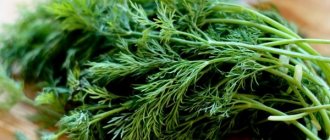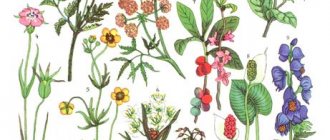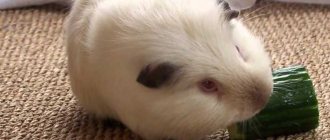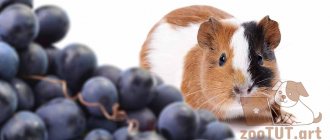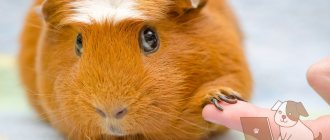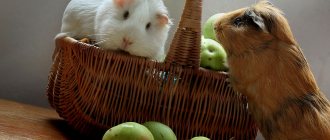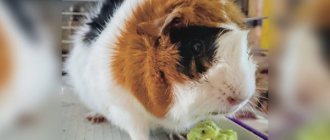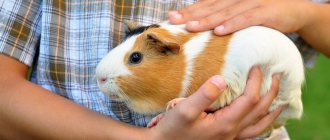- home
- Guinea pig
- Guinea pig nutrition
02/18/2019 Plant foods form the basis of the diet of guinea pigs, but even with obviously healthy products you need to be careful when it comes to feeding your beloved pet. It is worth considering whether guinea pigs can eat greens such as parsley and dill, and other similar plant products.
Dill
Dill contains carotene, thiamine, ascorbic acid, pectin, minerals and vitamins.
Dill is good for digestion - it reduces the formation of gases in the intestines, suppresses putrefactive processes, improves appetite and digestion, and stimulates milk production. The leaves and stem can be given, but only in small quantities due to the essential oil content. During pregnancy, it is better to reduce your dill consumption. Thus, the answer to the question “can guinea pigs eat dill” is yes, it is definitely possible and necessary to introduce dill into the diet of a domestic guinea pig.
cucumbers
Most often, owners are interested in whether guinea pigs can eat cucumbers. These vegetables contain 2-6% dry matter - sugars, fiber, protein, some vitamins and microelements. 94-98% of the total mass of a cucumber is water, so this vegetable has little nutritional value. But, despite this, cucumber helps the rodent’s body digest other foods and absorb fats. You can give cucumbers to guinea pigs in small quantities and, preferably, your own, since poisoning often occurs due to the nitrates contained in purchased cucumbers. Overfeeding cucumbers can lead to digestive problems.
Green feed
Many breeders, especially beginners, do not know what type of succulent green food they can offer their pets. After all, some herbs are dangerous not only to the life, but also to the health of domestic rodents.
We invite you to familiarize yourself with a fairly extensive list of permitted herbs:
- dandelion roots and leaves;
- sow thistle;
- shepherd's purse;
- coriander;
- peas;
- sprigs of dill, parsley;
- lettuce leaves;
- cilantro;
- celery;
- nettle;
- leaves and stems of beans, peas;
- leaves of plantain, yarrow;
- young corn shoots.
Ryegrass, vetch, sweet clover, oats and winter rye complete the list of permitted products.
Juicy plant products
The category of such food products includes vegetables and fruits. The diet should include mainly vegetables; fruit pulp is just a treat for guinea pigs. You should not give your pet too much fruit. Their pulp is saturated with sugars, which in excess are harmful to the body of a small animal. From time to time, the guinea pig is allowed to treat a small amount of cherries, apples, peaches, nectarines, apricots, pears, bananas.
The rodent enjoys eating vegetables and berries:
- carrots;
- white and cauliflower;
- zucchini;
- tomatoes;
- bell pepper;
- cucumber;
- corn;
- pumpkin;
- celery;
- seedless grapes;
- green peas.
It is useful to treat the animal once a week with berries rich in ascorbic acid: strawberries, currants, raspberries, wild strawberries. You can also periodically offer the animal leaves and twigs of cherries, blueberries, raspberries, gooseberries, and mint.
Eggplants and green tomatoes should not be included in the diet; these vegetables contain solanine, a toxic compound also present in green potatoes. It is strictly forbidden to give your pet leeks, onions and green onions. Bulb crops are poisonous to rodents.
Many owners are interested in whether it is possible to treat a guinea pig with melon and watermelon. The animal willingly feasts on such a treat and even eats watermelon rinds with pleasure. But you need to keep in mind that melon and watermelon are very sweet products, so you shouldn’t include them often in your diet.
You can diversify your pet's menu with fresh peas, soybeans, lentils, and green beans. It is useful to give your rodent juicy pea pods, rich in vitamins and nutrients.
Serving Size
There are three apple-related factors to consider when feeding your guinea pig apples:
- High sugar content;
- A large amount of vitamins;
- High concentration of acids.
It is better to cut the fruit. All these components, if contained in excess, can lead to digestive disorders, irritation of the mucous membranes and deterioration of the pet’s condition.
In this regard, you should feed your guinea pig fresh apples no more than three times a week. Moreover, it is worth giving it 2 - 3 slices, depending on the size of the fruit.
Dried fruits can be given in a bowl - every day in the morning, 3 - 4 slices.
But you cannot collect these seeds, store them separately for a long time and pour them out to your pet by the handful. The fact is that the skin of the seeds contains cyanic acid. Its concentration increases over time, making them poisonous. A large number of seeds, especially after long-term storage, lead to serious poisoning of the body and even the death of the pet.
Thus, a guinea pig can be fed fresh apples three times a week, and dried apples every day in the morning. Do not give soaked or compote-boiled apples. Apple seeds can only be given from fresh fruit in a few pieces; the seeds cannot be collected and stored separately, as extremely toxic cyanide acid accumulates in them.
Signs that it’s time to add dill and parsley to your dog’s diet
Dog owners should understand one rule - they should not radically change their dog’s diet too suddenly. If the body of a beloved pet lacks something from minerals, acids and vitamins, then the animal will show it with all its appearance.
The pet begins:
- Intensively gnawing earth, brick, plaster - there is a lack of calcium in the body.
- Ruining dirty socks or shoe insoles is a lack of B vitamins.
- Picking up cigarette butts is not enough vitamin P.
- Eating your own or someone else's feces - lack of vitamin B
The dog’s fur, as well as the condition of its eyes and the shape of its limbs can tell the owner that a dog’s body is deficient in any elements. The use of dill and parsley will help, together with other products, to replenish the pet’s body with everything it needs.
About the benefits of succulent feed
Nettle
Common stinging nettle has a number of beneficial properties and vitamins. It contains a lot of vitamin C, carotene, B vitamins and carotene. Fresh or dried nettle is a good natural vitamin concentrate. Young nettle leaves are also rich in protein, starch, chlorophyll, carbohydrates and iron salts, potassium and copper, manganese and titanium, nickel, many types of tannins and organic acids. Another advantage of nettle is that it is nutritious. Nettle leaves and shoots contain a large amount of proteins, fiber, and fats.
The leaves can be fed whole, or they can be made into powder and added to the main grain or concentrated feed. It is best to harvest nettles before flowering begins. Young shoots are mowed or only leaves are collected. Dry without pre-washing in a well-ventilated area, but out of direct sunlight.
Dandelion
This common and familiar plant is very useful for guinea pigs and in the summer it must be included in the animal’s diet. The leaves and roots of the plant are fed. Dandelion leaves are very rich in carotenoids, vitamin C, vitamins B and P. Dandelion leaves are good to use to improve digestion in animals, as well as to increase appetite. Dandelion roots are rich in sugar, inulin, and malic acid.
Spinach
Young spinach leaves are suitable for feeding. Spinach is also a source of large amounts of vitamins and proteins, iron salts, calcium and phosphorus. Just one hundred grams of spinach contains more than 700 mg of potassium.
Spinach can be fed not only fresh, but also dried and even frozen.
Cabbage
Headed cabbage is suitable for feeding fresh. Red cabbage is considered more nutritious and rich in vitamins. White and red cabbage is rich in vitamins C, carotene, B vitamins and iodine, pantothenic acid and many salts important for animal health. However, do not forget that cabbage leaves cause fermentation and gas formation in the intestines, so it is not recommended to feed a lot of cabbage leaves per day. Brussels sprouts can also be used to feed guinea pigs. It is rich in ascorbic acid, proteins, carotene, vitamins and salts of sodium, phosphorus and iron, as well as iodine and potassium.
Broccoli is also suitable for feeding. This type of cabbage is nutritious and high in sugar, carotenes, choline, and methionine. Broccoli is very rich in calcium. A big plus of broccoli is that it can be frozen and fed even in winter.
Lettuce leaves
Lettuce is a favorite food of guinea pigs. Regular leaf lettuce sprouts quite quickly and forms rosettes, so many breeders even grow it in pots at home. Lettuce leaves are rich in sugar and metals important for the guinea pig’s body:
- Potassium,
- Calcium,
- Iron.
Lettuce leaves contain almost all known vitamins and folic acid. Regular feeding of lettuce helps improve digestion and has a good effect on the pig's metabolism and appearance.
Parsley and dill
Our usual parsley and dill are high in vitamin C and carotene. Dill is especially recommended for guinea pigs during pregnancy and nursing. Dill not only increases milk production, but also improves the nutritional quality of milk. It is recommended to feed parsley to young animals and guinea pigs during the molting period, as well as after illness.
About the benefits of succulent feed
Nettle
Common stinging nettle has a number of beneficial properties and vitamins. It contains a lot of vitamin C, carotene, B vitamins and carotene. Fresh or dried nettle is a good natural vitamin concentrate. Young nettle leaves are also rich in protein, starch, chlorophyll, carbohydrates and iron salts, potassium and copper, manganese and titanium, nickel, many types of tannins and organic acids. Another advantage of nettle is that it is nutritious. Nettle leaves and shoots contain a large amount of proteins, fiber, and fats.
The leaves can be fed whole, or they can be made into powder and added to the main grain or concentrated feed. It is best to harvest nettles before flowering begins. Young shoots are mowed or only leaves are collected. Dry without pre-washing in a well-ventilated area, but out of direct sunlight.
Dandelion
This common and familiar plant is very useful for guinea pigs and in the summer it must be included in the animal’s diet. The leaves and roots of the plant are fed. Dandelion leaves are very rich in carotenoids, vitamin C, vitamins B and P. Dandelion leaves are good to use to improve digestion in animals, as well as to increase appetite. Dandelion roots are rich in sugar, inulin, and malic acid.
Spinach
Young spinach leaves are suitable for feeding. Spinach is also a source of large amounts of vitamins and proteins, iron salts, calcium and phosphorus. Just one hundred grams of spinach contains more than 700 mg of potassium.
Spinach can be fed not only fresh, but also dried and even frozen.
Cabbage
Headed cabbage is suitable for feeding fresh. Red cabbage is considered more nutritious and rich in vitamins. White and red cabbage is rich in vitamins C, carotene, B vitamins and iodine, pantothenic acid and many salts important for animal health. However, do not forget that cabbage leaves cause fermentation and gas formation in the intestines, so it is not recommended to feed a lot of cabbage leaves per day. Brussels sprouts can also be used to feed guinea pigs. It is rich in ascorbic acid, proteins, carotene, vitamins and salts of sodium, phosphorus and iron, as well as iodine and potassium.
Broccoli is also suitable for feeding. This type of cabbage is nutritious and high in sugar, carotenes, choline, and methionine. Broccoli is very rich in calcium. A big plus of broccoli is that it can be frozen and fed even in winter.
Lettuce leaves
Lettuce is a favorite food of guinea pigs. Regular leaf lettuce sprouts quite quickly and forms rosettes, so many breeders even grow it in pots at home. Lettuce leaves are rich in sugar and metals important for the guinea pig’s body:
- Potassium,
- Calcium,
- Iron.
Lettuce leaves contain almost all known vitamins and folic acid. Regular feeding of lettuce helps improve digestion and has a good effect on the pig's metabolism and appearance.
Parsley and dill
Our usual parsley and dill are high in vitamin C and carotene. Dill is especially recommended for guinea pigs during pregnancy and nursing. Dill not only increases milk production, but also improves the nutritional quality of milk. It is recommended to feed parsley to young animals and guinea pigs during the molting period, as well as after illness.
Other
Among other things, it is worth mentioning that guinea pigs do not tolerate processed foods: fried, boiled, pickled, baked, canned. The owner must not feed the pet food from his table. Including sweets: chocolate, marshmallows, cookies, etc.
Other prohibited products include:
- mushrooms;
- sauces - ketchup, mustard, etc.;
- sorrel;
- plantain.
There are special sweets for rodents - drops. They come in different flavors - berry, citrus, vegetable
Pets really like them, they should be used carefully and offered occasionally, like regular fruits. Drops contain sugar, which is harmful to animals
Before offering your pet something tasty, you should check the list of prohibited foods. If there is no information on a specific product, the best option is to put it aside and choose something else.
Features of feeding radishes
Vegetables that are classified as red-colored, such as seaweed, cabbage, rutabaga and radishes, can negatively affect your pet’s body. Of course, a small animal may be interested in a crispy and aromatic product, but no one knows what consequences can be expected from such feeding. These vegetables can cause stomach and intestinal disorders, diarrhea and bloating. Naturally, the guinea pig will experience discomfort, just like its owner.
The copious amounts of essential oils contained in radishes can cause irritation of the respiratory tract.
Rules for feeding vegetables
Basic rules for feeding vegetables to guinea pigs:
- Only fresh products are allowed for consumption. If the pet doesn't finish eating, the leftovers are thrown away.
- Vegetables, especially root vegetables, are thoroughly washed. There should be no dirt left on the peel.
- Lettuce and cabbage should be washed and dried before eating.
- The most useful vegetables are those collected from your own garden.
If you follow simple rules, your guinea pig will be in good health and in a good mood.
Dandelion
The most common question is: can guinea pigs eat dandelions? Dandelion is one of the most common plants, growing in a variety of places - in vegetable gardens, orchards, parks, fields, lawns, and also near roads.
You can give your guinea pig all parts of the plant - leaves, flowers, root and stem. But only the leaves and roots of this plant have nutritional value. Dandelion leaves contain carotene, choline, vitamin C, potassium, calcium, and iron. Inulin, sucrose, organic acids, various vitamins and microelements accumulate in the roots.
Dandelion leaves can be fed from early spring until late autumn. Substances contained in the leaves and roots of this plant stimulate appetite, enhance digestion, and cleanse the blood. But this plant cannot be given in large quantities. The amount of dandelion fed should not exceed 30% of the total daily intake of all green food.
Pet diet
In addition to vegetables, pigs eat dry food.
Guinea pigs are fed a specially formulated dry food, but eating vegetables and fruits is an important part of their diet. The daily dose of vitamin C is from 10 mg/kg to 30 mg/kg. When a guinea pig is pregnant or sick, the rate increases to a minimum of 30 mg/kg per day.
A small amount of grass, juicy tops and various vegetables are introduced into the daily food intake for rodents. In addition to hay and pelleted feed, add some fresh fruit. Good for supplementary feed:
- radish leaves;
- spinach;
- parsley;
- dandelion leaves.
In the autumn-winter period, it is recommended to introduce succulent food into the animal’s diet. A rodent should consume about 80-100 g of succulent food per day. This is only 20% of the daily requirement. The diet of an adult pet should be as varied as possible.
Poisonous plants
When going to a field or forest to look for green food for your pet, do not forget that there are dangerous plants that can cause not only severe poisoning, but also the death of your pet.
Not all grass can be eaten
Deadly plants
Remember this list of poisonous plants that guinea pigs should not eat:
- sorrel leaves;
- nightshade leaves and shoots;
- leaves of lilies of the valley, daffodils;
- aloe;
- arum;
- fighter;
- celandine;
- hyacinths;
- lily;
- fern;
- geraniums of all kinds;
- henbane;
- digitalis;
- wild radish;
- stinking dope.
Feeding with such plants can be fatal.
Food poisoning
The following plants, which can cause food poisoning, are considered no less dangerous for guinea pigs:
- ivy of all kinds;
- wild mustard;
- wisteria;
- gorse;
- honeysuckle;
- dogwood;
- yew;
- laurel;
- derain;
- hellebore;
- common broom.
Of the tree species, guinea pigs are prohibited from giving hellebore and belladonna greens, privet, mistletoe, oleander, thuja, juniper and elderberry.
If you come across a poisonous plant
There is nothing wrong with this if, while feeding grass, the animal eats a couple of poisonous leaves or twigs. After all, as you know, poisons in small quantities are medicine. The degree of concentration of toxic substances in plants depends on the time of day and year.
Guinea pigs have a unique sense of touch and smell, so the animals themselves determine which food is best for them and will not harm them.
If it happens that the pig tastes a poisonous plant and feels unwell, it will remember it and avoid it next time.
Melissa
Like peppermint, lemon balm perfectly soothes the stomach and can normalize the functioning of the intestines and the entire digestive system. A small amount of this greenery can relieve the feeling of spasm, but you should not overdo it with feeding either.
Sources:
https://svinki.ru/doc/%D0%BF%D0%B8%D1%82%D0%B0%D0%BD%D0%B8%D0%B5-%D0%BC%D0%BE%D1% 80%D1%81%D0%BA%D0%B8%D1%85-%D1%81%D0%B2%D0%B8%D0%BD%D0%BE%D0%BA/%D0%BC%D0% BE%D0%B6%D0%BD%D0%BE-%D0%BB%D0%B8-%D0%BC%D0%BE%D1%80%D1%81%D0%BA%D0%BE%D0% B9-%D1%81%D0%B2%D0%B8%D0%BD%D0%BA%D0%B5/%D0%BC%D0%BE%D0%B6%D0%BD%D0%BE-%D0 %BB%D0%B8-%D0%BC%D0%BE%D1%80%D1%81%D0%BA%D0%BE%D0%B9-%D1%81%D0%B2%D0%B8%D0 %BD%D0%BA%D0%B5-%D1%83%D0%BA%D1%80%D0%BE%D0%BF/ https://moy-homyachok.ru/morskie-svinki/mozhno-li- morskim-svinkam-ukrop.html https://homjakam.ru/morskaya-svinka/pitanie-svinok/petrushku-i-ukrop
About the benefits of succulent feed
Nettle
Common stinging nettle has a number of beneficial properties and vitamins. It contains a lot of vitamin C, carotene, B vitamins and carotene. Fresh or dried nettle is a good natural vitamin concentrate. Young nettle leaves are also rich in protein, starch, chlorophyll, carbohydrates and iron salts, potassium and copper, manganese and titanium, nickel, many types of tannins and organic acids. Another advantage of nettle is that it is nutritious. Nettle leaves and shoots contain a large amount of proteins, fiber, and fats.
Many breeders dry nettles to prevent vitamin deficiency in guinea pigs at the end of winter.
The leaves can be fed whole, or they can be made into powder and added to the main grain or concentrated feed. It is best to harvest nettles before flowering begins. Young shoots are mowed or only leaves are collected. Dry without pre-washing in a well-ventilated area, but out of direct sunlight.
Dandelion
This common and familiar plant is very useful for guinea pigs and in the summer it must be included in the animal’s diet. The leaves and roots of the plant are fed. Dandelion leaves are very rich in carotenoids, vitamin C, vitamins B and P. Dandelion leaves are good to use to improve digestion in animals, as well as to increase appetite. Dandelion roots are rich in sugar, inulin, and malic acid.
Spinach
Young spinach leaves are suitable for feeding. Spinach is also a source of large amounts of vitamins and proteins, iron salts, calcium and phosphorus. Just one hundred grams of spinach contains more than 700 mg of potassium.
Spinach can be fed not only fresh, but also dried and even frozen.
Cabbage
Headed cabbage is suitable for feeding fresh. Red cabbage is considered more nutritious and rich in vitamins. White and red cabbage is rich in vitamins C, carotene, B vitamins and iodine, pantothenic acid and many salts important for animal health. However, do not forget that cabbage leaves cause fermentation and gas formation in the intestines, so it is not recommended to feed a lot of cabbage leaves per day. Brussels sprouts can also be used to feed guinea pigs. It is rich in ascorbic acid, proteins, carotene, vitamins and salts of sodium, phosphorus and iron, as well as iodine and potassium.
Cauliflower is a valuable source of vitamins B and P; it is especially recommended to feed it to pregnant guinea pigs, as well as to females during lactation and young animals.
Broccoli is also suitable for feeding. This type of cabbage is nutritious and high in sugar, carotenes, choline, and methionine. Broccoli is very rich in calcium. A big plus of broccoli is that it can be frozen and fed even in winter.
Lettuce leaves
Lettuce is a favorite food of guinea pigs. Regular leaf lettuce sprouts quite quickly and forms rosettes, so many breeders even grow it in pots at home. Lettuce leaves are rich in sugar and metals important for the guinea pig’s body:
Lettuce leaves contain almost all known vitamins and folic acid. Regular feeding of lettuce helps improve digestion and has a good effect on the pig's metabolism and appearance.
Parsley and dill
Our usual parsley and dill are high in vitamin C and carotene. Dill is especially recommended for guinea pigs during pregnancy and nursing. Dill not only increases milk production, but also improves the nutritional quality of milk. It is recommended to feed parsley to young animals and guinea pigs during the molting period, as well as after illness.
Parsley
Parsley contains a lot of vitamin C and A, minerals; root parsley contains vitamins A, C, PP and group B. The root and green parts are suitable for guinea pigs to eat. The essential oils contained in parsley have a beneficial effect on the digestive system.
Parsley stimulates contraction of the uterine muscles and can cause premature birth, so this greenery should not be fed to pregnant females. Also, parsley is not recommended for consumption by lactating females, as it negatively affects lactation. So can a guinea pig eat parsley?
Article on the topic: Is it possible to give strawberries to guinea pigs?
Other
Among other things, it is worth mentioning that guinea pigs do not tolerate processed foods: fried, boiled, pickled, baked, canned. The owner must not feed the pet food from his table. Including sweets: chocolate, marshmallows, cookies, etc.
Other prohibited products include:
- mushrooms;
- sauces - ketchup, mustard, etc.;
- sorrel;
- plantain.
There are special sweets for rodents - drops. They come in different flavors - berry, citrus, vegetable
Pets really like them, they should be used carefully and offered occasionally, like regular fruits. Drops contain sugar, which is harmful to animals
Before offering your pet something tasty, you should check the list of prohibited foods. If there is no information on a specific product, the best option is to put it aside and choose something else.
Vitamin C for Guinea Pigs
The body of pets, unlike animals living in nature, lacks the enzyme that is required to convert consumed glucose into vitamin C. That is, the physiology of a pig kept at home does not allow it to produce ascorbic acid on its own.
This feature of the animal’s body entails the need for the owner to constantly feed the pet with foods and preparations containing vitamin C. A lack of this substance in the rodent’s diet can lead to serious illnesses (in particular, scurvy) and even death.
Guinea pigs need vitamins all year round. During the warm season, feeding your pet with fresh foods will help provide your pet with a sufficient amount of ascorbic acid:
- Green herbs, leaves, stems, etc.;
- fruits and vegetables.
In winter, the lack of natural substances in the animal’s diet will have to be compensated by adding synthetic drugs to the food.
It is important to emphasize that, regardless of the time of year, increased consumption of ascorbic acid is needed:
- baby pigs;
- females who have already given birth and are preparing to give birth;
- animals that are sick or recovering from illness.
Foods containing vitamin C
Many foods are rich in ascorbic acid of organic origin. To ensure your rodent has sufficient intake of this substance, it is worth feeding it with the following products:
- basil;
- broccoli;
- raspberry branches;
- cabbage;
- kiwi;
- nettle;
- black currant leaves (possibly with twigs);
- burdock;
- mint;
- dandelions (with leaves);
- bell pepper;
- parsley;
- tomato;
- fennel;
- coniferous branches;
- spinach;
- apples.
All these products should be collected in environmentally friendly areas - away from highways, factories, etc. Plants should not be treated with any chemicals, otherwise they are deadly to the animal.
The inclusion of the listed products in sufficient quantities in the rodent’s diet eliminates the need to additionally give it synthetic vitamin supplements in its food. They will only be needed in the cold season, when natural plant products are not available.
Ascorbic acid in ampoules
In winter, when the content of nutrients in the diet decreases, it is necessary to strengthen the pet’s immunity with the help of synthetic additives. If you don’t want to bother with powders or tablets, you can purchase ascorbic acid in liquid form - in the form of a five percent solution.
The drug is administered to the pet using an insulin syringe (without a needle, of course). The optimal daily dosage is 0.5 ml. In some cases, the dose of the drug is doubled - up to 1 ml, but only as prescribed by a veterinarian.
Where to collect and how to properly process herbs
Grass for guinea pigs should be collected exclusively in clean areas, away from landfills, garbage cans, busy highways, and industrial facilities. Do not store grass and tree cuttings where dogs are walked or livestock is grazed .
Did you know? When stroked by the owner, the guinea pig can sometimes make sounds similar to the purring of a cat.
Near fields and vegetable gardens, where plots are often fertilized with pesticides and nitrates, it is also prohibited to collect greens for pets. In places where there are a large number of trees (forest, grove, park), stocking up on food is also not worth it, since ticks may accumulate there. The grass should be picked in an open meadow, away from all possible sources of pollution.
